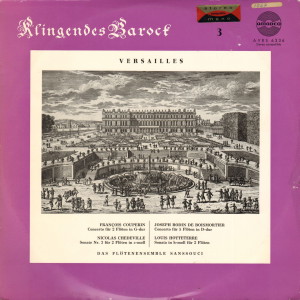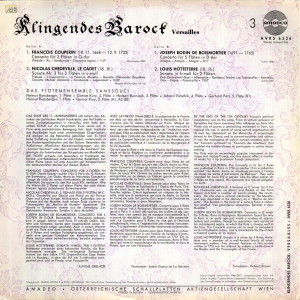 |
1 LP -
Amadeo AVRS 6336
|
 |
|
| VERSAILLES -
Klingendes Barock - 3 |
|
|
|
|
|
| François
Couperin (10.11.1668 - 12.9.1733) |
|
|
| Concerto für 2
Flöten in G-dur |
7' 47" |
A1
|
| - Prélude - Air
- Sarabande - Chaconne legere |
|
|
|
|
|
| Nicolas Chedeville, Le
Cadet (18. Jh.) |
|
|
| Sonate Nr. 3 für
2 Flöten in c-moll |
12' 33" |
A2 |
| -
Prélude - L'Impératrice - La
Palatine, Musette - Gavotte
allemande/Deuxiéme Gavotte/Menuet
allemand - Sarabande - Legerement |
|
|
|
|
|
| Joseph Bodin de
Boismortier (1691-1765) |
|
|
| Concerto für 5
Flöten in D-dur |
8' 17" |
B1 |
| - Allegro -
Adagio - Allegro |
|
|
|
|
|
| Louis Hotteterre
(18. Jh.) |
|
|
| Sonata in h-moll
für 2 Flöten |
13' 07" |
B2 |
| - Duo
(Gravement-Gay) - Allemande -
Rondeaau, Tendre, Les
Tourterelles - Rondeau, Gay -
Gigue - Passacaille |
|
|
|
|
|
| DAS FLÖTENENSEMBLE
SANSSOUCI |
|
- Helmut
Riessberger, 1. Flöte
(A1, A2, B2)
|
|
| - Gernot Kury, 2.
Flöte (A1, A2, B2) |
|
| - Herbert Reznicek,
3. Flöte |
|
| - Johann Futschik, 4.
Flöte |
|
- Gerhard Perz, 5.
Flöte (B1)
|
|
|
|
|
|
Luogo
e data di registrazione |
|
-
|
|
|
Registrazione:
live / studio |
|
studio |
|
|
Edizione LP |
|
AMADEO
- AVRS 6336 - (1 lp) - durata 41'
44" - (p) 1966 - Analogico |
|
|
Altre edizioni
LP
|
|
MUSICAL
HERITAGE SOCIETY - MHS 574 - (1
lp) |
|
|
Prima Edizione
CD |
|
- |
|
|
Note |
|
Stereo
compatible
|
|
|
|
|
By the end
of the 17th century
France's political
ascendancy was on the
wane. From its virtual
seclusion at Versailles
the Court exercised little
influence on Paris life.
There was of course a
centralising movement in
Paris, but musical life
was in search of some sort
of organisation of its own
less dependent on the
Monarchy. It accordingly
turned to the Opera, and
to concert-societies and
salons. It was the
emergence of public
concert-societes such as
the "Concerts spirituels"
or "Concert
des Amateurs" that enabled the
middle-classes to
partecipate in active
musicmaking.
The
flute was an
exceedingly popular
instrument in
baroque and rococo
France, and this
record offers a
number of works for
it by prominent French
composers.
FRANÇOIS
COUPERIN. This
Concerto in G
for 2 flutes
was pubblished
in Paris in 1724
as number 13 in
a collection
entitled "Les Goûts
réunis, ou
nouveaux
concerts à
l'usage de
toutes les
sortes
d'instruments de
Musique". They
were intended
for Louis XIV in
person. Like the
other pieces for
2 flutes on
this record,
this Concerto
is a typical
polyphonic suites.
NICHOLAS
CHEDEVILLE. 3
Sonatas in C
minor for 2
flutes.
Chedeville was
an oboist and
flautistat the
Paris Opera
and had a
number of
pupils among
the
aristocracy.
He was also a
virtuoso
performer on
the Musette,
and was
described in
his obituary
as a "Maître
de Musette".
This Sonata in
the form of a
suite is from
a collection
entitled "Les
galanteries
amusantes,
Sonates à deux
Musettes".
JOSEPH
BODIN DE
BOISMORTIER:
Concerto in D
major for 5
flutes. Born
at Perpignan,
Boismortier
found his way
to Paris at an
early age and
wrote a number
of operas,
ballets and
cantatas,
though his
reputation
rests mainly
on his
instrumental
works, in
which the
flute is
always well to
the fore. This
Concerto
aspires not so
much to
polyphony as
to
instrumental
colour, and is
remarkable for
the almost
orchestral
quality of its
texture.
LOUIS
HOTTETERRE:
Sonata in B
minor for 2
flutes.
Hotteterre was
a member of a
well-known
family of
windinstruments
makers. Two
unusual
features of
this sonata
written in
1712 are the
attempt to
imitate a
turtle-dove in
the Rondo, and
the
Passacaglia of
the Finale.
Alfons Übelhör
(Translation:
Richard
Rickett)
|
|

